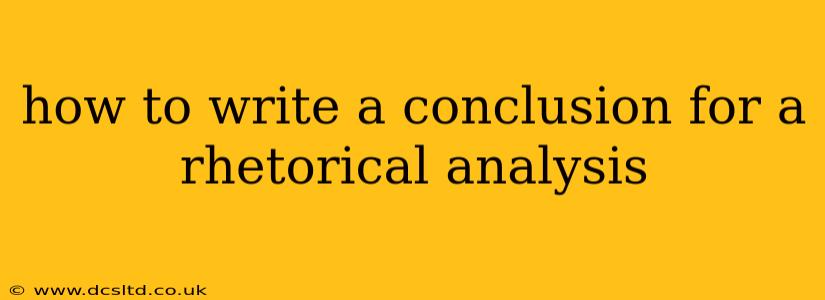How to Write a Killer Conclusion for a Rhetorical Analysis
Writing a strong conclusion for a rhetorical analysis is crucial; it's your final chance to leave a lasting impression on your reader. It shouldn't just summarize your points; it should synthesize them, offer a fresh perspective, and leave the reader with something to ponder. Here's a breakdown of how to craft a compelling conclusion:
1. Restate Your Thesis (But Don't Just Repeat It):
Begin by subtly restating your thesis. Avoid a simple rehash. Instead, rephrase your central argument, highlighting the key insights you've uncovered through your analysis. For example, instead of saying, "This essay analyzed how Martin Luther King Jr. used ethos, pathos, and logos in his 'I Have a Dream' speech," you might say, "Through a close examination of King's masterful use of rhetorical appeals in his 'I Have a Dream' speech, we see how he effectively mobilized a nation towards a shared vision of equality." Notice the shift from a factual statement to a more insightful observation.
2. Synthesize Your Main Points:
Briefly revisit your main points, but don't simply list them. Instead, show how they connect and support your overall argument. Highlight the interconnectedness of your findings. For instance, you might say something like, "King's powerful use of pathos, combined with his carefully constructed logos and undeniable ethos, created a rhetorical masterpiece that transcended its time and continues to inspire today." This approach demonstrates a deeper understanding of the subject than a simple summary.
3. Offer a Broader Significance or Implication:
This is where your conclusion truly shines. Move beyond the specifics of your analysis and explore the wider implications of your findings. How does your analysis contribute to a larger understanding of the text, the author, or the historical context? What are the broader societal or cultural implications? For example, you could discuss how King's rhetorical strategies continue to influence modern persuasive communication, or how his speech shaped the Civil Rights Movement. This step elevates your analysis from a simple deconstruction to a meaningful interpretation.
4. Provide a Thought-Provoking Closing Statement:
End with a memorable sentence or two that leaves the reader with something to consider. This could be a provocative question, a concise summary of your main insight, or a call to further reflection. Avoid clichés; aim for originality and impact. Examples:
- "Ultimately, King's success demonstrates the enduring power of rhetoric to shape not only public opinion but also the course of history."
- "The enduring effectiveness of King's 'I Have a Dream' speech underscores the vital role of effective communication in achieving social change – a lesson we can all learn from and apply today."
- "Considering the timeless relevance of King's rhetoric, we are left to ponder: How can we harness the power of persuasive language to address the contemporary challenges facing our world?"
5. Avoid Introducing New Information:
The conclusion is not the place to introduce new arguments or evidence. Stick to summarizing, synthesizing, and extending the points already made in your essay.
Example Transition Phrases for a Conclusion:
- In conclusion,...
- Therefore,...
- Ultimately,...
- In essence,...
- To summarize,...
- As we have seen,...
- From this analysis, we can conclude...
- This rhetorical analysis reveals...
By following these steps, you can craft a conclusion that is not only well-written but also impactful and memorable, leaving a lasting impression on your reader and demonstrating a mastery of rhetorical analysis.
